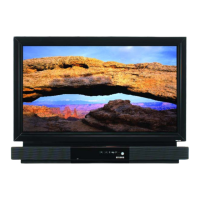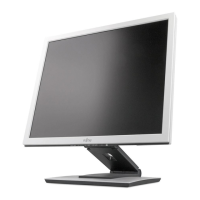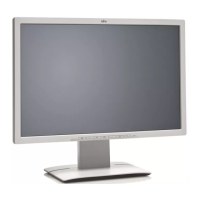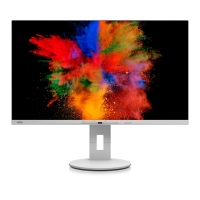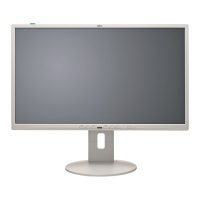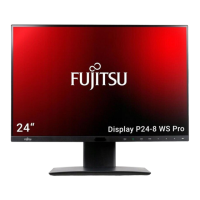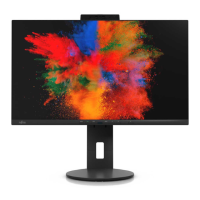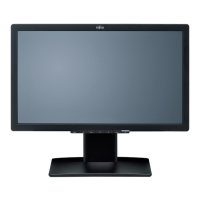What to do if my Fujitsu P34-9 UE says 'No Signal'?
- Nnicholas53Aug 4, 2025
If your Fujitsu Monitor displays 'No Signal', ensure the data cable is correctly attached to the monitor port on your computer and verify that the computer is switched on.
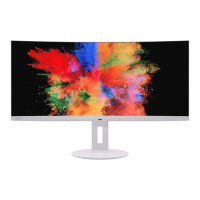
What to do if my Fujitsu P34-9 UE says 'No Signal'?
If your Fujitsu Monitor displays 'No Signal', ensure the data cable is correctly attached to the monitor port on your computer and verify that the computer is switched on.
Why is my Fujitsu P34-9 UE screen blank but the power light is on?
If your Fujitsu Monitor screen is not displaying anything but the power indicator is lit, first check that the computer is switched on. Then, ensure the monitor's data cable is correctly attached to the computer's port. Try pressing any key on the keyboard, as the computer may be in power-saving mode. Finally, adjust the brightness and contrast settings until a picture appears.
How to fix 'Frequency out of range' on Fujitsu P34-9 UE Monitor?
If your Fujitsu Monitor displays the message 'Frequency out of range', it means the input signal doesn't match the monitor's technical data. Adjust the video frequency range using your computer's software, referring to its documentation. Alternatively, set a different screen resolution using the computer software.
Why is there no current through the USB port on my Fujitsu Monitor?
If your Fujitsu Monitor's USB port isn't providing power, ensure you're using the USB-C cable supplied or a certified equivalent, as your device might be triggering overcurrent protection. Disconnect the device, inspect it for defects, and then reconnect it. Connect a computer to a USB port designated as 'Upstream' to activate the lateral USB ports. For devices needing high charge levels (up to 65W), connect them to the USB-C port on the monitor's underside.
Why is my Fujitsu P34-9 UE not displaying anything and the power light is off?
If your Fujitsu Monitor screen is not displaying anything and the power indicator isn't lit, check that the power cable is correctly connected to the monitor and make sure the computer is switched on.
Why does the Daisy Chain not work on my Fujitsu Monitor?
If the daisy chain feature isn't working on your Fujitsu Monitor, it could be due to insufficient bandwidth for the second monitor. Try reducing the display refresh rate and/or the color depth in the graphics settings of your system.
| Pixel pitch | 0.2325 x 0.2325 mm |
|---|---|
| Display diagonal | 34.1 \ |
| Display technology | LED |
| Native aspect ratio | 21:9 |
| Maximum refresh rate | - Hz |
| Viewable size, vertical | 335 mm |
| Contrast ratio (typical) | 1000:1 |
| Display number of colors | 1.073 billion colors |
| Viewable size, horizontal | 800 mm |
| Digital vertical frequency | 28 - 102 Hz |
| Digital horizontal frequency | 30 - 160 kHz |
| Display brightness (typical) | 400 cd/m² |
| Supported graphics resolutions | 640 x 480 (VGA), 800 x 600 (SVGA), 1024 x 768 (XGA), 1280 x 1024 (SXGA), 1280 x 720 (HD 720), 1440 x 900 (WXGA+), 1600 x 900, 1680 x 1050 (WSXGA+), 1920 x 1080 (HD 1080), 1920 x 1200 (WUXGA), 2560 x 1080, 2560 x 1440 |
| AMD FreeSync | Yes |
| Number of speakers | 2 |
| Product color | Gray |
| Market positioning | - |
| Sustainability certificates | EPEAT Gold, ENERGY STAR |
| DisplayPort version | 1.2 |
| USB Type-A downstream ports quantity | 4 |
| USB Type-C downstream ports quantity | 1 |
| Tilt angle range | -4 - 34 ° |
| Cable lock slot type | Kensington |
| AC input voltage | 100 - 240 V |
| AC input frequency | 50 - 60 Hz |
| Energy efficiency scale | A to G |
| Power consumption (off) | 0.24 W |
| Power consumption (standby) | - W |
| Power consumption (typical) | 33.34 W |
| Power consumption (PowerSave) | 0.26 W |
| Operating temperature (T-T) | 5 - 35 °C |
| Operating relative humidity (H-H) | 10 - 85 % |
| Package depth | 325 mm |
| Package width | 935 mm |
| Package height | 500 mm |
| Package weight | 12650 g |
| Cables included | AC, DisplayPort, HDMI, USB Type-A to USB Type-B, USB Type-C to USB Type-C |
| DisplayPort cable length | 1.8 m |
| Harmonized System (HS) code | 85285210 |
| Depth (with stand) | 275 mm |
|---|---|
| Height (with stand) | 390.3 mm |
| Weight (with stand) | 8950 g |
| Depth (without stand) | 109.39 mm |
| Width (without stand) | 814.82 mm |
| Height (without stand) | 372.8 mm |
| Weight (without stand) | 6220 g |
Identifies the intended audience for the manual's instructions.
Provides additional details on setting resolution, refresh rates, and ergonomics.
Explains symbols, fonts, and formatting used throughout the manual.
Outlines essential safety precautions for device installation and operation.
Details guidelines for using and replacing the monitor's power cable.
Provides instructions on how to safely pack and move the monitor.
Explains the proper methods for cleaning the monitor's surface and casing.
Lists EU directives the device complies with for EMC, safety, and environmental standards.
Guides users on environmentally friendly disposal and recycling of the device.
Instructs on unpacking, verifying contents, and checking for transport damage.
Provides guidance on ensuring proper ventilation and device placement.
Details optimal positioning for the monitor, keyboard, and user for comfort.
Explains how to adjust the monitor's vertical height for optimal viewing.
Describes how to tilt the monitor forward or backward for comfortable viewing.
Details how to rotate the monitor for different viewing orientations.
Guides on how to detach the monitor base for mounting with accessories.
Explains how to connect the monitor to power and data sources.
Covers connecting data cables and power for the monitor and computer.
Explains how to power the monitor on and off and the status LED indicators.
Details the functions and optimal usage of ambient light and presence sensors.
Describes the purpose and function of the monitor's control panel buttons and OSD menu.
Guides on how to select the desired language for the On-Screen Display menu.
Explains how to adjust image settings like sharpness, saturation, and hue.
Details how to configure and use the Picture-in-Picture display mode.
Covers settings for OSD language, timeout, and rotation.
Explains advanced features like Presence Sensor, Daisy Chain, FreeSync, and DDC/CI.
Shows how to access and view monitor technical details like model and serial number.
Guides on activating and deactivating the energy-saving ECO mode.
Explains how to choose the active video input source for the monitor.
Details preset modes like DICOM, sRGB, Office, Photo, Video, and Custom.
Covers adjusting colour temperature (K) and RGB channels for display.
Explains how to set the volume for the integrated loudspeakers and mute them.
Details how to adjust brightness, contrast, and black level for optimal display.
Describes how to lock the OSD menu to prevent unauthorized changes.
Explains how to lock the monitor's power button to prevent accidental use.
Guides on connecting multiple monitors in a daisy-chain configuration.
Provides instructions for installing monitor drivers via Device Manager.
Details the process for installing network drivers using setup.exe.
Explains DisplayView's presence sensor config for power saving and security.
Describes how DisplayView allows screen content rotation based on orientation.
Details using DisplayView to divide the desktop into multiple areas for windows.
Outlines specific BIOS settings for ESPRIMO G for All-in-One operation.
Details BIOS settings for LIFEBOOK/STYLISTIC for All-in-One functionality.
Explains how to configure the monitor's power button for All-in-One control.
Guides on setting up Windows power options for seamless All-in-One operation.
Explains pixel and subpixel faults and their relation to ISO 9241-307 standards.
Lists the physical dimensions, weight, and image size of the monitor.
Details video signals, frequencies, power supply, and power consumption.
Lists common PC and video timings supported by the monitor.
Details the meaning of each pin in the Displayport connector.
Details the meaning of each pin in the HDMI connector.
Explains the pin assignment and function of the USB-C port.
